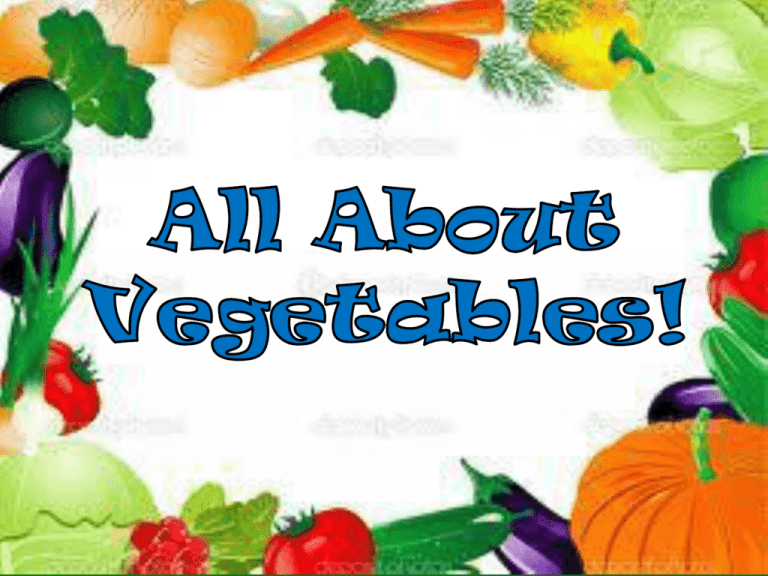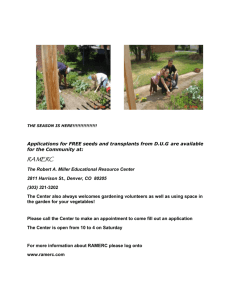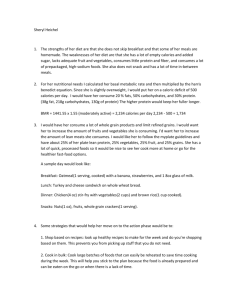Vegetables
advertisement

After today, you will be able to select, prepare, and store vegetables safely and properly Let’s get started! Defining Vegetables Vegetables are colorful, flavorful and nutritious. Hundreds of different kinds can be prepared in many different ways. You need 3-5 servings from the Vegetable Group each day. Forms of Vegetables Fresh Frozen Canned Fresh veggies have the most nutrients. Buying Vegetables Signs of freshness: – Solid-should feel heavy in relation to its size. – Good color- not too pale or too dark. – Crisp or firm. – In good condition-no decay, soft spots or damage. Fresh vegetables are sold loose or in packages. Buying for the Season Saves money and Fresher Food FALL- squash, cauliflower, SPRING- artichokes, asparagus, carrots, chives, fava beans, garlic, ginger, mushroom, fennel, mustard greens, pumpkin, sweet potatoes potatoes, spinach, lettuce, sugar snap peas and onions. WINTER- kale, leeks, radishes, rutabaga and SUMMER-beets, broccoli, turnips cabbage, corn, cucumber, eggplant, green beans, squash, tomatoes and zucchini Storing Most vegetables should be refrigerated as soon as you bring them home. If they’re wet, shake off the excess water. Too much moisture can make it spoil faster. Don’t wash them until you are ready to prepare or eat Potatoes and onions should be stored separately in a cool, dry, dark area. Frozen vegetables are available to buy packaged individually or mixed. Canned vegetables are available whole, sliced, or in pieces. Already cooked. Only need to be reheated according to directions. Preparing Raw Vegetables Wash them to remove dirt and harmful bacteria. Using cold water, and sometimes a brush. Cut damaged spots and parts that can’t be eaten. Cooking Vegetables Cooking makes them easier to chew and digest. Lose few nutrients Stay bright in color Are tender and crisp Have a mild, mellow flavor. • Steaming- One of the most healthy ways to cook, because fewer nutrients are lost since vegetable is not in water -Vegetable is cooked over, not in, water to help prevent nutrient loss • Simmering- about ½ cup of water in saucepan, cover and bring to a boil. Add veggies, cover and simmer until tender -Do not use aluminum or copper pans (minerals react with sulfur compounds in veggies, resulting in loss of vitamin C, E and Folic Acid) • Microwaving- Cooks food quickly, using only a small amount of water. Keeps nutrients, color, texture and flavor. -pierce skinned vegetables with a fork, to avoid vegetable from bursting -Always cover containers to keep in moisture • Baking- Vegetables with a high moisture content bake in an oven. • Winter squash, potatoes and sweet potatoes • Pared whole vegetables such as carrots, onions, and potatoes can be baked in the same pan as a roast, but adds fat • Frying- Most vegetables are capable of being sautéed, stir fried, and deep fried. • Sautéed- sometimes done before a recipe to bring out the flavor Both of these methods (frying and sauté)are used with oil, which adds fat and calories to the vegetables. Especially with deep fried vegetables. Parts of the Plant Fruit Flowers Roots Seeds Leaves Stems Leaves Flower Stem Fruit Seeds Roots What Part Of The Plant Do You Eat??? Roots They are the pathways for water to travel from the soil to the plant; they store nutrients. They also anchor the plant in the ground. Two categories * BULBS- onions, radishes and garlic *TUBERS- carrots and potatoes High in starch and calories. Ex: Onions, Carrots, Potatoes, Radishes, Garlic, Turnips, and Beets Stems They support the plant. Slender stalks are more tender. They are high in water and low in calories Ex: Celery and Asparagus Leaves They capture the sunlight to make the food for the plant (photosynthesis) The darker the leaves the higher the nutrient content. They are high in water and low in calories. Ex: Spinach, Lettuce, Cabbage, Brussel Sprouts, and Sprouts. Flowers These are the blooms of the plant. Ex: Cauliflower, Broccoli and Artichoke They are high in water and low in calories. QUICK DEBATE! Is a TOMATO a Fruit or a Vegetable!? Let’s Think… It has a thin layer of smooth skin and seeds inside like a pome… It has a fragile cell structure like a berry… Sometimes it has a sweeter taste than most vegetables do… The answer is… Technically…it’s BOTH! Scientifically speaking…the tomato is a fruit due to its structure and physical characteristics as well as the part of the plant it comes from (the fruit of the plant). It can be classified as a berry because of its fragile structure and amount of seeds inside. In the culinary world…a tomato is classified as a vegetable because it is used in savoury dishes rather than sweet ones. Savoury is defined as salty or spicy which represents the tomato's flavor in most foods. So technically speaking, the tomato IS the FRUIT of the tomato plant but it is used as a VEGETABLE in cooking. Do you know other fruits that are mistaken as vegetables? -Avocado -Eggplant -Cucumber -Squash -Peppers -Olives -Pumpkins Fruit They contain the seeds of the plant. They are not sweet like the foods we call fruit. They are high in water and low in calories. Ex: Tomatoes, Cucumbers, Eggplant, Bell Peppers, Other Peppers, Pumpkin, Squash, and Green Beans Seeds They store nutrients so that other plants can be grown. They are high in starch and high in calories. Ex: Peas, Corn, Sunflower Seeds, and Lima Beans Create a Vegetable! Using your notes about the different parts of the plant, create a new or hybrid vegetable Ex: Cucumber plus a Carrot = Cu-arrot Make sure you use class time wisely! The winner will be determined on who used time in class best as well!! Be creative! Make it colorful!! The pair with the best creation will win a prize! …it’s a surprise



